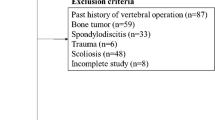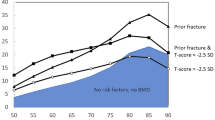Abstract
Because no gold standard for the definition of vertebral fracture exists, there has been controversy about whether mild vertebral deformities are truly fractures or simply normal variation in vertebral size and shape. The aim of this study was to assess the associations of mild variations of vertebral height ratios to definite vertebral fractures. In 479 Japanese women (age 53.9±9.1 years) who visited our institute for a medical checkup, we performed lateral lumbar radiographs and morphometric parameters were derived by measuring the anterior (Ha), middle (Hm) and posterior (Hp) height of each vertebral body from T12 to L4. Vertebral height ratios, Ha/Hp, Hm/Hp or Hp/Hp′ of adjacent vertebrae that were more than 3 SD different from vertebra-specific means of normative data were considered to indicate fractures. Forty-five women were diagnosed with at least one fracture. After excluding the subjects with vertebral fracture, we examined the associations of the variations in vertebral height ratios with age, anthropometric parameters and lumbar bone mineral density (BMD) measured by dual-energy X-ray absorptiometry. Vertebral height ratios, especially Hm/Hp in postmenopausal women, tended to decrease with age and were positively associated with BMD. No significant correlation was observed between anthropometric parameters and vertebral height ratios. Age-related decrease in vertebral height ratios (Ha/Hp and Hm/Hp, each averaged from T12 to L4) was significant even after the correction for BMD. Mean values of height ratios of non-fractured vertebrae adjusted for age and BMD were significantly lower in postmenopausal women with vertebral fracture than in those without vertebral fracture. Logistic regression analysis showed that BMD and height ratios of non-fractured vertebrae were independent predictors of vertebral fracture risk. The results suggest that older women, and women with at least one obvious (3 SD) fracture, tend to have mild deformities which do not qualify using the 3 SD definition. These mild deformities may represent real consequences of osteoporosis, because they are more pronounced among women with obvious fracture.
Similar content being viewed by others
References
Riggs BL, Melton LJ III. Involutional osteoporosis. N Engl J Med 1986;314:1676–86.
Melton LJ III, Kan SH, Frey MA, Wahner HW, O'Fallon WM, Riggs BL. Epidomiology of vertebral fracture in women. Am J Epidemiol 1989;129:1000–11.
Eastell R, Cedel SL, Wahner HW, Riggs BL, Melton LJ III. Classification of vertebral fractures. J Bone Miner Res 1991;6:207–15.
McCloskey EV, Spector TD, Eyres KS, et al. The assessment of vertebral deformity: a method for use in population studies and clinical trials. Osteoporosis Int 1993;3:138–47.
Genant HK, Wu CY, Kuijk CV, Nevitt MC. Vertebral fracture assessment using a semiquantitative technique. J Bone Miner Res 1993;8:1137–48.
National Osteoporosis Foundation Working Group on Vertebral Fractures. Assessing vertebral fractures. J Bone Miner Res 1995;10:518–23.
Kleerekoper M, Nelson DA. Vertebral deformity or vertebral fracture? Calcif Tissue Int 1992;50:5–6.
Kanis JA, McCloskey EV, Khan S, Nakatsuka K, Sirtori P. What is vertebral fracture? In: Christiansen C, Riis B, editors. Proceedings of the Fourth International Symposium on Osteoporosis and Consensus Development Conference, 27 March–2 April, Hong Kong. Aalborg, Denmark: Handelstrykkeriet Aalborg, 1993:26–8.
Parfitt AM, Duncan H. Metabolic bone disease affecting the spine. In: Rothman R, Simeone F, editors. The spine, 2nd ed. Philadelphia: WB Saunders, 1982:775–905.
Smith-Bindman R, Cummings SR, Steiger P, Genant HK. A comparison of morphometric definitions of vertebral fracture. J Bone Miner Res 1991;6:25–34.
Black DM, Cummings SR, Stone K, Hudes E, Palermo L, Steiger P. A new approach to defining normal vertebral dimension. J Bone Miner Res 1991;6:883–92.
Heuck A, Block J, Glüer CC, Steiger P, Genant HK. Mild versus definite vertebral osteoporosis: comparison of bone densitometry techniques using different statistical models. J Bone Miner Res 1989;4:891–900.
Hedlund LR, Gallagher JC, Meeger C, Stoner S. Change in vertebral shape in spinal osteoporosis. Calcif Tissue Int 1989;44:168–72.
Garton MJ, Robertson EM, Gilbert FJ, Gomersall L, Reid DM. Can radiologists detect osteopenia on plain radiograph? Clin Radiol 1994;49:118–22.
Pødenphant J, Nielsen VAH, Riis BJ, Gottfredsen A, Christiansen C. Bone mass, bone structure and vertebral fractures in osteoporotic patients. Bone 1987;8:127–30.
Yu W, Glüer CC, Grampp S, et al. Spinal bone mineral assessment in postmenopausal women: a comparison between dual X-ray absorptiometry and quantitative computed tomography. Osteoporosis Int 1995;5:433–9.
Black DM, Palermo L, Nevitt MC, et al. Comparisons of methods for defining prevalent vertebral deformities: the study of osteoporotic fractures. J Bone Miner Res 1995;10:890–902.
Ross PD, Huang C, Davis JW, Wasnich RD. Vertebral dimension measurements improve prediction of vertebral fracture incidence. Bone 1995;16:257S-62S.
Ito M, Hayashi K, Yamada M, Nakamura T. Vertebral measurements for assessment of osteoporosis. Br J Radiol 1994;67:759–63.
Author information
Authors and Affiliations
Rights and permissions
About this article
Cite this article
Sone, T., Tomomitsu, T., Miyake, M. et al. Age-related changes in vertebral height ratios and vertebral fracture. Osteoporosis Int 7, 113–118 (1997). https://doi.org/10.1007/BF01623685
Received:
Accepted:
Issue Date:
DOI: https://doi.org/10.1007/BF01623685




